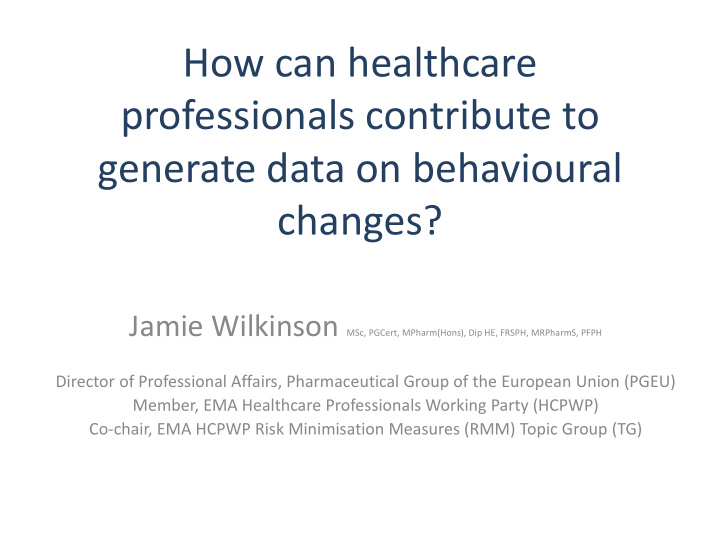



How can healthcare professionals contribute to generate data on behavioural changes? Jamie Wilkinson MSc, PGCert, MPharm(Hons), Dip HE, FRSPH, MRPharmS, PFPH Director of Professional Affairs, Pharmaceutical Group of the European Union (PGEU) Member, EMA Healthcare Professionals Working Party (HCPWP) Co-chair, EMA HCPWP Risk Minimisation Measures (RMM) Topic Group (TG)
Background EMA’s Healthcare Professionals’ Working Party (HCP WP) Topic Group on Risk Minimisation Measures (RMM TG), Oct 2015 - Present Scope of this presentation Share some of the learnings from the TG and implications for regulators and HCPs
Creation of the RMM TG Conclusions from the Sept 2015 EMA Workshop on RMMs Optimise use of current regulatory tools Collaboration with HCPs & patients is key to developing RMMs Understand factors that affect adherence to RMMs by patients & HCPs Effective communication A more systematic approach to measuring the effectiveness of RMMs at different levels
Collaboration with HCPs & patients HCP WP RMM “Topic Group” (TG) Pts & HCPs should be Created along side several other involved early in design: • thematic TGs end of 2015 - both to optimise existing and develop Objectives new RMMs • Discuss current practices/experience in - as much can be learnt from those with • development/implementation of RMMs real-life experience of implementation of RMMs, e.g. nurses, pharmacists. Brainstorm how to facilitate input from HCPs • into the feasibility, information and evaluation of RMMs; product-specific issues, therapeutic class and overall therapeutic environment Discuss how to better inform HCPs on ongoing • activities/initiatives in the EU regulatory Engagement: network for post-authorisations and prepare recommendations as appropriate. - can take place through the existing frameworks of EMA’s working parties Survey of HCP WP on 4 recent RMMs • - as well as through new interactions Analysis & recommendations ready • with other organisations and Next steps…. • individuals.
Understand factors that affect adherence to RMMs HCP WP RMM “Topic Group” (TG) To avoid Created along side several other • unnecessary thematic TGs end of 2015 burden, • Well balanced regulators need Objectives • • Feasible to ensure that risk Discuss current practices/experience in • minimisation development/implementation of RMMs measures are: Brainstorm how to facilitate input from HCPs • into the feasibility, information and evaluation of RMMs; product-specific issues, therapeutic class and overall therapeutic environment Discuss how to better inform HCPs on ongoing • Consideration activities/initiatives in the EU regulatory should also be • E.g. lack of safer network for post-authorisations and prepare given to alternatives when recommendations as appropriate. unintended restricting access to a consequences critical medicine Survey of HCP WP on 4 recent RMMs • of a measure: Analysis currently underway • Next steps…. •
Understand factors that affect adherence to RMMs HCP WP RMM “Topic Group” (TG) (As previously described) A strong network and communication channels that allow healthcare Impact of Pharmacovigilance professionals to engage with patients and PRAC Strategy 2 regulators needs to be in This Workshop 3 place. PRAC strategy has identified four key areas of Regulators need to focus: engage further with stakeholders and more is 1. Effectiveness of risk minimisation actions to be done to create an atmosphere of risk 2. Effectiveness of specific pharmacovigilance awareness without undermining trust. processes 3. Enablers of effective pharmacovigilance including stakeholder trust and engagement 4. Method identification and development
Overview of Survey HCPs (primary & secondary care, specialist & generalist) completed questionnaire over summer 2016 Implementation and adherence to RMMs in practice – what works well and what are the barriers? Tailored (for each RMM), structured, closed questionnaire with open space for comments to elaborate / give practice experience Valproate, high strength insulin, bisphosphonates/denosumab & fentanyl patches
Challenges - Questions Optimisation of existing RMMs and development of new RMMs Balance & proportionality Feasibility Unintended consequences of an RMM
Challenges - Answers Packaging needs to be If a medication is clearly designed for all Space on packaging for available in multiple users (e.g. colour blind / strengths, there is visually impaired insulin pharmacy labels? always a risk? users) and to prompt HCPs in counselling Delay between launch of DHCPs - Lost in the post? RMM and regular use of Surgery? Ward? medication Pharmacy?
Challenges - Answers Set number of Information Vague checklists – “information overload (checklists, not diagnosis / materials” per pack cards, condition specific used for multiple communications patients from all areas) Health system Not all HCPs have hierarchy & access to diagnoses reporting / indications
Opportunities - Questions Learnings from those New tools Ensuring with real-life Message allow instant correct media experience adapted to access to & correct tool implementing each online used for each RMMs, e.g. audience information situation nurses, pharmacists
Opportunities - Answers Involve HCPs earlier on Guides should cover all in the development HCPs involved in process medication use Target communications Use of scientific with appropriate tool publications / and to appropriate communications / audience, using mixed events media
Opportunities - Answers Integration into Incorporate into Point of prescribing Institutional education of HCPs / dispensing protocols / (CE/CPD*) software alerts guidelines Access to shared Multi-professional eHealth records collaboration & (with indications / shared diagnoses) responsibilities *Continuing Education / Continuous Professional Development
Some Practice-based Solutions (from professional organisations) Research Ready Pharmacies (e.g. Professional Audit UK) in Practice Real World (various) Evidence (e.g. GP-Pharmacist PT) Pharmacotherapy Meetings (e.g. GP & “PTAMs” in NL) Pharmacist eHealth: Dossier Quality Pharmaceutique Circles (e.g. Partagé (e.g. FR, NL, DE, PT, BE) Error process Good Pharmacy CH) database (e.g. Practices “Patientsikkerhed” (pharmacovigilance DK) e.g. ES) Communication from EU-Level Organisations?
References 1 http://www.ema.europa.eu/ema/index.jsp?curl=pages/news_and_events/events/2015/08/event_detail_001193.jsp&mid=WC0b01ac058004d5c3 2 http://www.ema.europa.eu/docs/en_GB/document_library/Other/2016/01/WC500199756.pdf 3 http://www.ema.europa.eu/docs/en_GB/document_library/Other/2016/04/WC500204177.pdf 4 http://www.ema.europa.eu/ema/index.jsp?curl=pages/news_and_events/events/2016/07/event_detail_001311.jsp&mid=WC0b01ac058004d5c3 5 http://www.ema.europa.eu/ema/index.jsp?curl=pages/news_and_events/events/2016/08/event_detail_001316.jsp&mid=WC0b01ac058004d5c3 6 http://www.ema.europa.eu/ema/index.jsp?curl=pages/regulation/general/general_content_000658.jsp&mid=WC0b01ac0580961211 7 http://www.portalfarma.com/Profesionales/consejoinforma/Paginas/Buenas-practicas-Farmacia-Comunitaria.aspx 8 https://www.researchgate.net/publication/278716124_Pharmacotherapeutic_Circles 9 https://www.medicijngebruik.nl/english/products-and-services 10 http://aop.sagepub.com/content/40/9/1640.abstract 11 http://www.ordre.pharmacien.fr/Le-Dossier-Pharmaceutique/Qu-est-ce-que-le-DP 12 http://www.apb.be/fr/corp/Le-pharmacien/role-et-taches-principales/Pages/Dossier-pharmaceutique-partage.aspx 13 https://www.gov.uk/government/publications/toolkit-on-the-risks-of-valproate-medicines-in-female-patients 14 https://www.gov.uk/government/publications/e-learning-modules-medicines-and-medical-devices/e-learning-modules-medicines-and-medical-devices 15 http://pro.medicin.dk/Generelt/Patientsikkerhed 16 http://www.rpharms.com/science-and-research/research-ready.asp
Recommend
More recommend